02 May 2023
How to write a short essay | Guide

Short essays typically require you to answer a question involving your course content and may range from 200 to 750 words. This depends on your professor's guidelines. It may seem easy to write a short essay before you face the most challenging bit, squeezing in informative data on a broad topic. You won't have to worry about that anymore if you learn how to write a short essay. Read on to see how you should go about it to meet the paper's intent.
Writing a Short Essay
The writing process takes a lot of time and effort. You must constantly practice to hone your skills. A proper short essay format needs to take into account the thesis statement, main point, and tangentially related secondary topics. This is really difficult when you have a limited word count such as 200 words to work with.
You need an introductory paragraph, multiple arguments about a particular topic and the final paragraph to highlight key features in the essay. Addressing only key points requires surgical precision to demonstrate a clear idea and produce a good short essay.
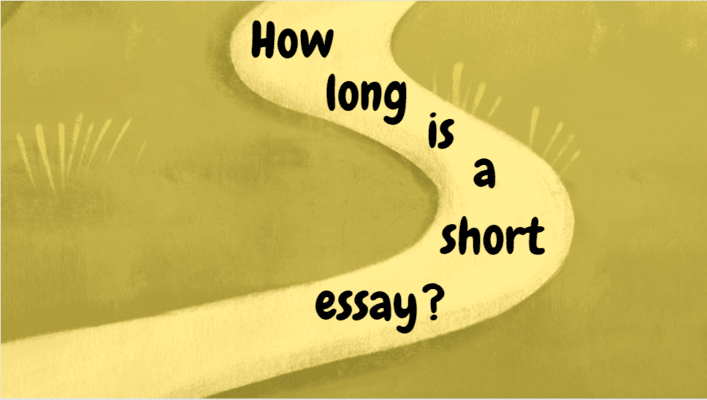
Short Essay Length- How long is a Short Essay?
This is the most common question posed by students that aim to write short essays. While there is no standard, a brief essay will likely follow a certain format.
A short essay's length ranges between half a page and one page. In most cases, a short essay takes about 400 words to finish. However, some papers reach 750 words. You'll find short essays everywhere, from personal statement essays to reflection papers. Regardless of the essay type, meeting the word limit is important to show the reader that you can work with limited words to describe a phenomenon accurately. Here are 6 key steps to guide you on how to write a short essay.
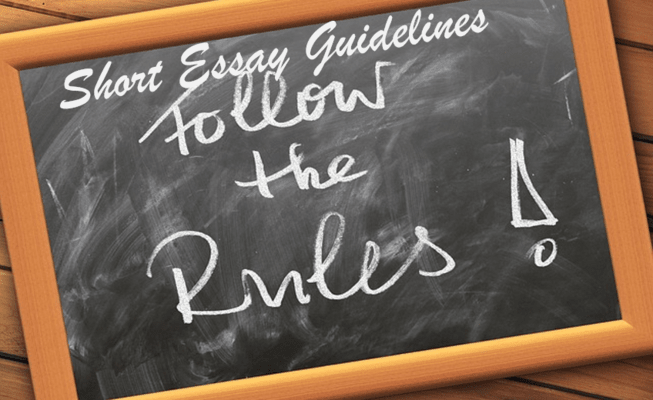
Short Essay Guidelines
Your assignment requires a plan to go on smoothly. Look at these steps to form a structure that you'll use to write your paper.
Note the question you must answer
Determine if the central point can be broken into smaller sections. Ensure you cover each section in your answer
1. Read the essay prompt
-Note the question you must answer
-Determine if the central point can be broken into smaller sections. Ensure you cover each section in your answer
2. Brainstorm the points and arguments you discern would best address the question
3. Select three of the strongest points and come up with a supporting example, argument, or reference for each of these.
4. Use the correct short essay format for your outline. This will help you structure your points and connect them to supporting info
5. Create a draft with an accurate short essay structure, including the following:
a) Introduction
b) Main body paragraphs
c) Quotations
d) Conclusion

a) Introduction
Do not dawdle. Get to the point. Short essay writing does afford room to maneuver. You should introduce the main point in this section using a strong thesis statement. This is your main argument and incorporates the language used in the prompt to frame your thesis statement. Ensure you include a sentence that helps readers understand what you will discuss. Keep it short but specific, and keep the reader's interest by providing minimal contextual information. Refrain from bombarding them with too much detail to keep your essay short.
You have to hit the ground running from the first sentence in your first paragraph to avoid having too many ideas in your essay. Address the points in the order that they appear in your preview sentence.
b) Main Body Paragraphs
Remember to use a sensible topic sentence to introduce each paragraph to help strengthen your essay writing. Summarize each paragraph's points without information spilling over to the next paragraph. Have a sensible structure where the key idea in the topic sentence echoes your preview sentence to help readers connect your origin and determine how the argument is progressing.
Despite the length, a good essay uses sentences as opposed to bulleted points to ensure all the main points have supporting evidence. This is better achieved using body paragraphs.
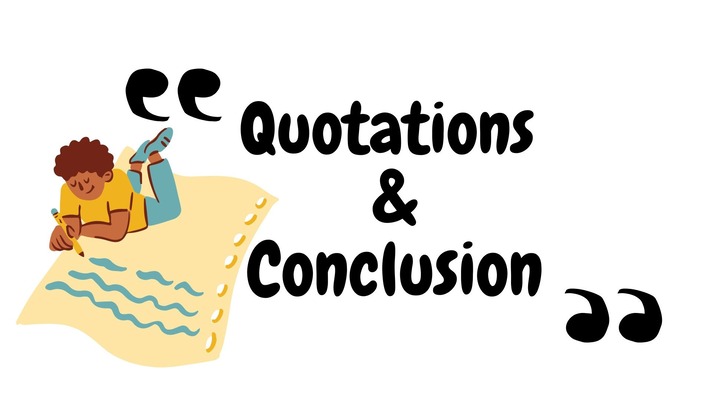
c) Quotations
Using quotations in essay writing is a bit tricky. It is generally accepted that a writer can only use quotations to back up their points. Quotations must also be less than 10% of your paper to score high grades. Remember to document your sources, whether you derived them from class readings or other sources such as books.
d) Conclusion
Create a brief summary of your argument and connect it to your thesis statement.
6. Revise and edit your draft
-Writing short essays requires conciseness and accurate direction. Write sentences purposefully to avoid repetition to make every word count. Do not deviate from your topic. Write a short essay that answers the question succinctly. Remove any fluff and check the grammar and punctuation when you reread the draft. Check your reference list, footnotes, endnotes, or in-text citations where applicable to ensure they are properly documented.
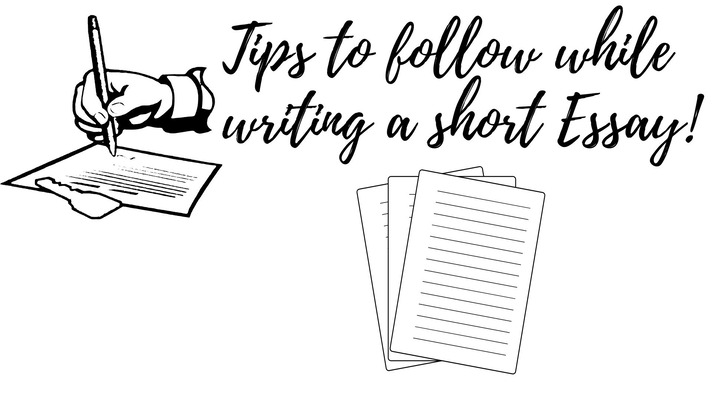
Tips To Follow While Writing a Short Essay
Short essay writing needs structure; otherwise, you will lose marks for using an improper essay format. You will typically find these types of assignments helpful to help you with your academics. Your college application essay is a form of short essay. Learning how to write a short essay helps make the college application process easier. Without further ado, let's look at five tips to follow when writing a short essay.
- Research
- Brainstorm
- Outline
- Write
- Edit/proofread
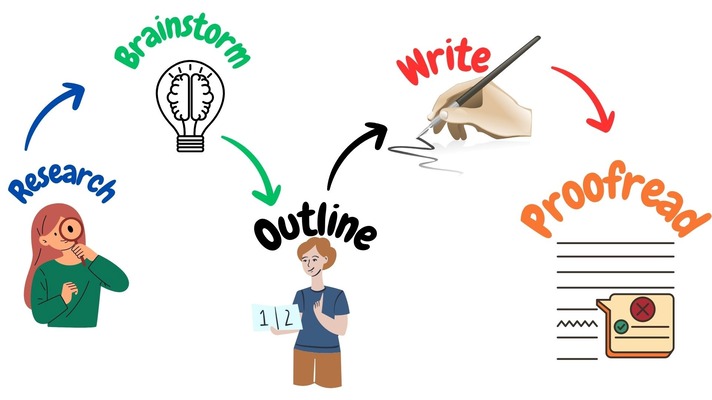
1. Research
Find relevant source materials for your brief essay before you begin writing. The good news is, since the short essay length is, well, short, you'll normally need a few sources: two or three should suffice. Use relevant sources from journals and books. Pay attention to the sources' dates and focus on the more updated ones. Also, make sure your sources are peer-reviewed.
How long is a Short Essay?
Avoid wasting time by reading each document's summary or abstract to get the main ideas. Does it seem useful? Remember, the mini-essay limits your room to maneuver. Each source must contribute something to your short story.
2. Brainstorm
You'll find it impossible to write a short essay without accurately understanding each idea present in the notion. Think about the main ideas you want to express and stay focused, especially to meet the short essay format and meet the word count.
You must intricately express yourself in each topic, ensuring you remain on-topic and are precise. For this, you should develop a clear notion of what you'll write about.
3. Outline
Creating an outline for your short essay is the next logical step once you're done brainstorming appropriate facts to include in your essay. Now that you have a topic sentence linked to the main idea in your thesis statement, you need to start writing down your ideas and other details that support them.
This will help you maintain the correct bearing once you start writing. Creating an outline is one of the most important parts of writing a paper, particularly if your professor assigned you a broad topic.
There is a looming threat of chaotic thoughts messing up your flow here, so write down all your arguments and probable criticisms before you start writing. Focus on your final goal and ascertain what you will cover in each paragraph.
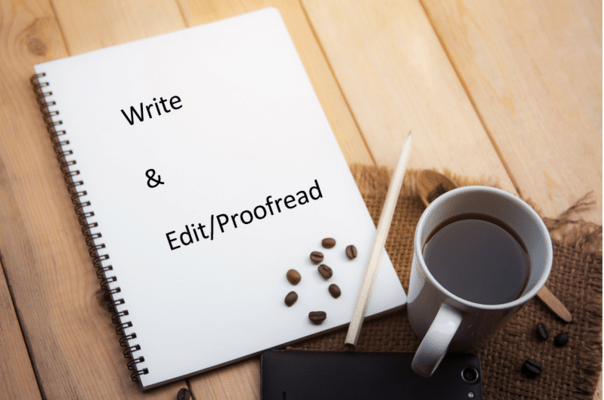
4. Write
Once you're done writing the outline, it is time to come up with your brief essay. How many paragraphs you write depends on your topic. One thing to remember when you're writing college essays is to focus on one idea. Your main point creates a lasting first impression and determines how your audience will react to the rest of the paper. So, make sure that you bring your A game!
If you're done with the previous step, doing this won't be hard. You have your sources and an excellent outline. All that's left to do is follow the latter and add the former. Remember that this is an assignment on how to write a short essay, be brief and concise. Address your points quickly but adequately. Use an active voice and avoid lengthy verb phrases.
5. Edit/proofread
College students must make it a habit to edit and proofread short essays. Make sure your work accurately reflects your train of thought and sounds good. Unclear and rushed work does not benefit anyone. Writing essays requires perfect expression. You may have all the ideas, but big orthographic and grammatical mistakes will lead to a low score.
Proofreading your essay is the best way to make sure you are using correct grammar and do not have these kinds of mistakes in your work. Use grammar checkers if possible and remain extra meticulous.

Begin With the Introductory Paragraph
Some of you must wonder why this is a subtopic when learning how to write a short essay. After all, what will be in the first paragraph if the third paragraph is the conclusion? Is it possible to have an essay with three paragraphs if two encompass the introduction and conclusion paragraphs? Can one paragraph work as the body? The answer to all these questions is yes.
How to Start a Short Essay?
Use an opening hook in one paragraph to serve as your essay introduction. This draws more people to your work. Remember, how many paragraphs one uses in the paper depends on the content and essay instructions. However, do not exceed the word limit. Subdivide the word count into three sections: 2/3 for the body and 1/3 equally split between the introduction and conclusion.
Components of a Short Essay
Despite the short essay length, it must follow a five-paragraph structure. This includes the following factions to help your paper be easier to understand and elaborately structured.
- Introduction (first paragraph)
- Thesis
- Main body (three paragraphs)
- Conclusion (last paragraph)
1. Introduction
First impressions make or break an essay, even if you're working on a short essay. Your introduction paragraph must serve a purpose. Its intention is to draw readers in and direct them to the rest of your document. So, your goal here is to come up with a hook that intrigues your audience.
Your introduction should not exceed five sentences. Make your work informative, catchy, and concise. Writing a short essay requires a bold claim on the problem's urgency. You must persuade the audience about the worth of your essay. Don't take a half page to draw them in, though. You need to start immediately and capture the reader from the moment you start writing your short essay.
2. Thesis
Learning how to write a short essay is kind of pointless if you do not have good transition words, that is, linking words that shine a spot on your thesis statement. This is the most important part of your writing as it guides the reader to what you intend to write about. In essence, the thesis statement demonstrates what you want to point out concerning the topic.
Write your thesis as the last sentence in your short essay gives you a framework to direct your writing for the rest of the document.
3. Main Body
Short essay writing is interestingly difficult at this point. Short essay examples are not in high supply and information on most topics is so wide it may be difficult to siphon out the important stuff.
Write your main body in sections, with each paragraph reflecting one of your arguments. Do not dwell on one section as your essay will be too long. A short and concise essay is well-structured and has information tapering from the strongest to the weakest.
Leave room for dissenting information to prevent critics from getting any avenue to attack your thesis. While your document is short, clearly subdividing the body will help you write an essay that succinctly covers your topic.
4. Conclusion
The last section of your essay is reserved for your final thoughts. A short essay definition addresses the same points as any other. So its conclusion's format is similar to any other paper. Take a look at different short essay examples to discern how you can adequately summarize your document in one paragraph while meeting the word limit.
Short essays need extra care because of their length. Use one sentence to address each paragraph and how they work together to demonstrate the accuracy of your thesis.

Tips for Successful Essay Writing
Now that we've addressed the most important aspects of writing short essays, let's look at some things you should do during the writing process to guarantee success.
- Select an interesting topic
- Know your audience
- Use online editing/proofreading tools
Selecting an interesting topic allows you to dive right into your assignment without deeming it as such. It is more fun than work. With this in mind, a student can structure their writing to meet their audience's interests. Using online proofreading tools allows you to score higher marks by eliminating errors that may have escaped you as you edited and proofread the work earlier.

Summary of the Above Components
We will also sum up our article with a conclusion that summarizes what we have covered.
Short essays contain three sections. Every paragraph must address one idea but maintain a flow with the rest of the document. Your introduction should explain each paragraph in a sense. Depending on your essay topic, the essay may extend to about five paragraphs. Once again, remember to use a catchy tone that addresses the reader's questions. They must get the message. Always place a thesis statement within your introduction. We have used a paper with three paragraphs to come up with support for this statement.